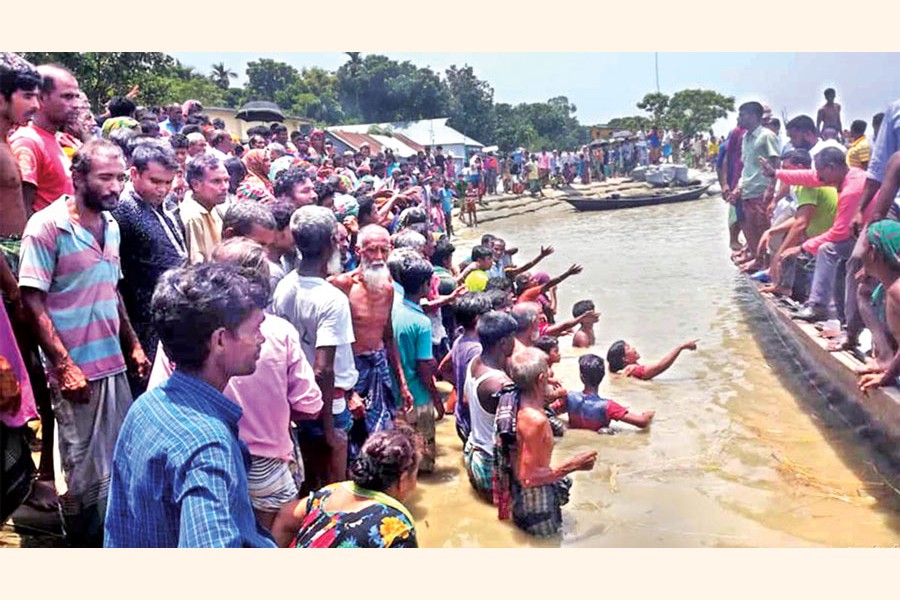 Hundreds of flood-affected people rushing towards an approaching boat on the river Jamuna in Islampur, Jamalpur, for relief materials on Friday — Focus Bangla
Hundreds of flood-affected people rushing towards an approaching boat on the river Jamuna in Islampur, Jamalpur, for relief materials on Friday — Focus Bangla Flood situation deteriorated at many places in northern and central regions, even if water levels of many rivers started to fall on Friday.
Thousands of flood victims, however, remained hungry and vulnerable to diseases like diarrhoea as relief supplies were scanty to meet their needs.
However, 14 rivers at 22 points in 15 districts were flowing above the danger mark on the day, according to the state-run Flood Forecasting and Warning Centre (FFWC).
FFWC in its evening update said Jamuna and Padma rivers would continue to swell in the next 48 hours.
The situation in Manikganj, Rajbari, Faridpur and Munshiganj districts might deteriorate during the period, it predicted.
Padma at Shureswar point and Old Brahmaputra at Jamalpur might cross the danger mark, causing further flooding at places of Shariatpur and Jamalpur districts.
However, FFWC said flood situation in some northern and central districts might improve in the next 24 hours.
But many places in the districts under review got deluged on Friday, with parts of river dams falling apart.
A dam at Poragram under Bharatkhali union in Gaibandha collapsed, inundating Gaibandha-Shahghata regional highway.
Padumshahar, Bonarpara, Bharatkhali and Kochua unions in Gaibandha were fully inundated while rail link between Shantahar, Lalmonirhat and Rangpur remained snapped, according to the Water Development Board in Gaibandha.
Meanwhile, the disaster management and relief ministry said 0.12 million out of over 3.0 million marooned people took shelter in eight districts until Friday morning.
Many in the shelter centres complained about getting inadequate relief materials.
Thousands are living in the open on embankments amid threats of river erosion.
Kurigram is among the worst flood-hit areas where 90 per cent of land is already under floodwater, according to the Water Development Board.
A total of 0.75 million people have been partly or fully affected there, but only 35,600 took shelter in 145 centres, sources said.
According to the ministry, 1,000 tonnes of rice, 6,000 packets of dry food and 500 tents were distributed in the district in the last one week.
Omar Faruq, a Kurigram Sadar resident, got a packet of dry food in the last three days.
It contains one-and-a-half kilogram of flattened rice, one kilogram of salt, quarter kilogram of molasses and a water bottle.
The government was also giving 10-kilogram rice to each flood-hit family, but the allotment was much less than the demand for his six-member family, Mr Faruq said.
The affected people in Nilphamari, Gaibandha, Lalmonirhat, Naogaon, Bogura, Tangail, Sunamganj, Sylhet and elsewhere shared the same experience.
Our correspondents from flood-hit districts said hundreds were living under the open sky on the embankments without emergency aid.
They said the government has a lack of preparedness this year to combat flood disaster.
The ministry concerned said 5,200 tonnes of rice were distributed alongside Tk 5.2 million and 18,000 dry-food packets for the victims in the last five days.
A report by bdnews24.com says, the International Federation of Red Cross and Red Crescent Societies said floods put more than 4.0 million people at risk of food insecurity and diseases, reports.
Thousands are left stranded, without power and electricity, as floods and landslides ravage roads and vital infrastructure while 66,000 homes have been destroyed, it added.
Food and clean water shortages are being reported, as well as a rise in waterborne diseases.
© 2024 - All Rights with The Financial Express
